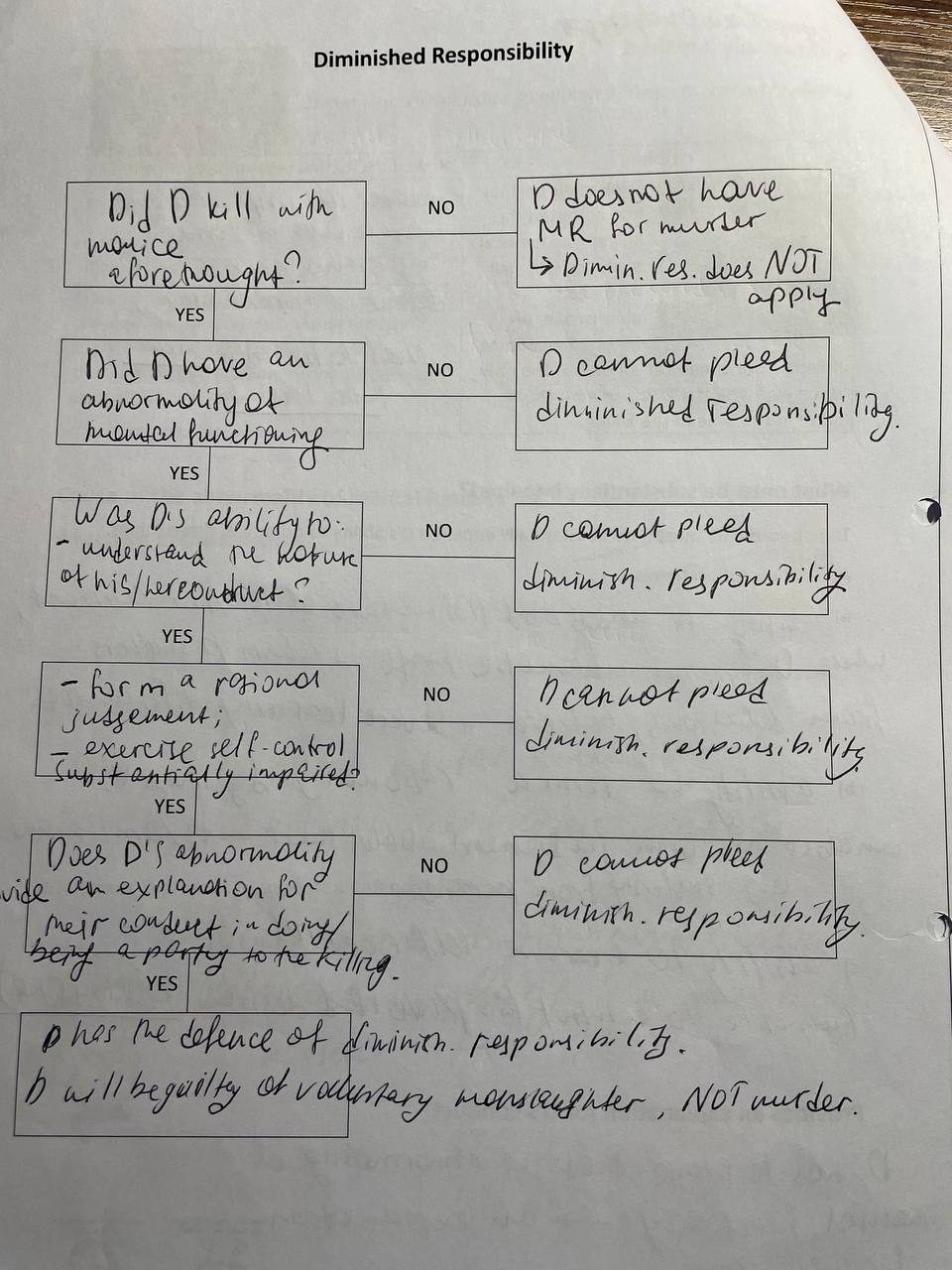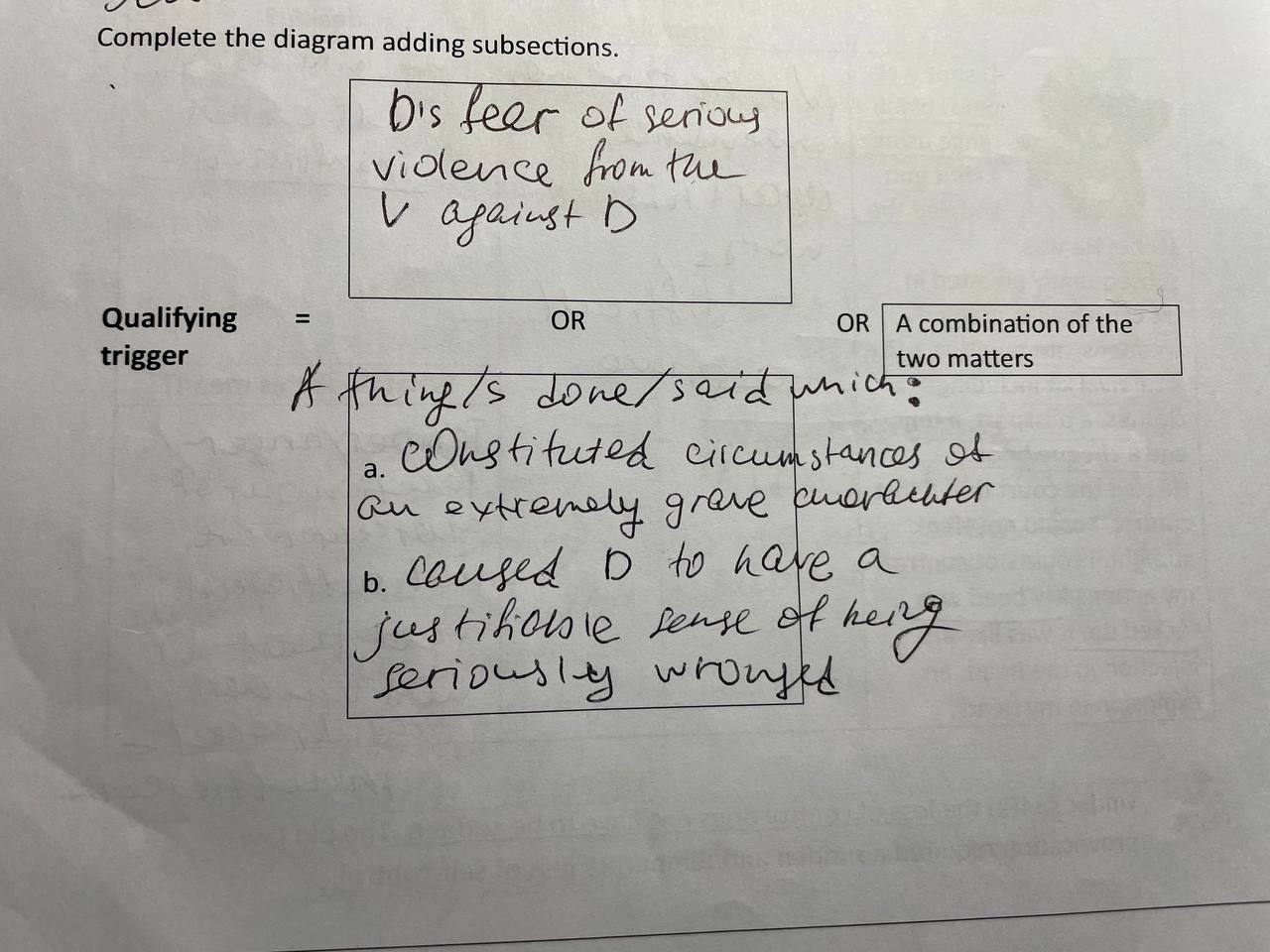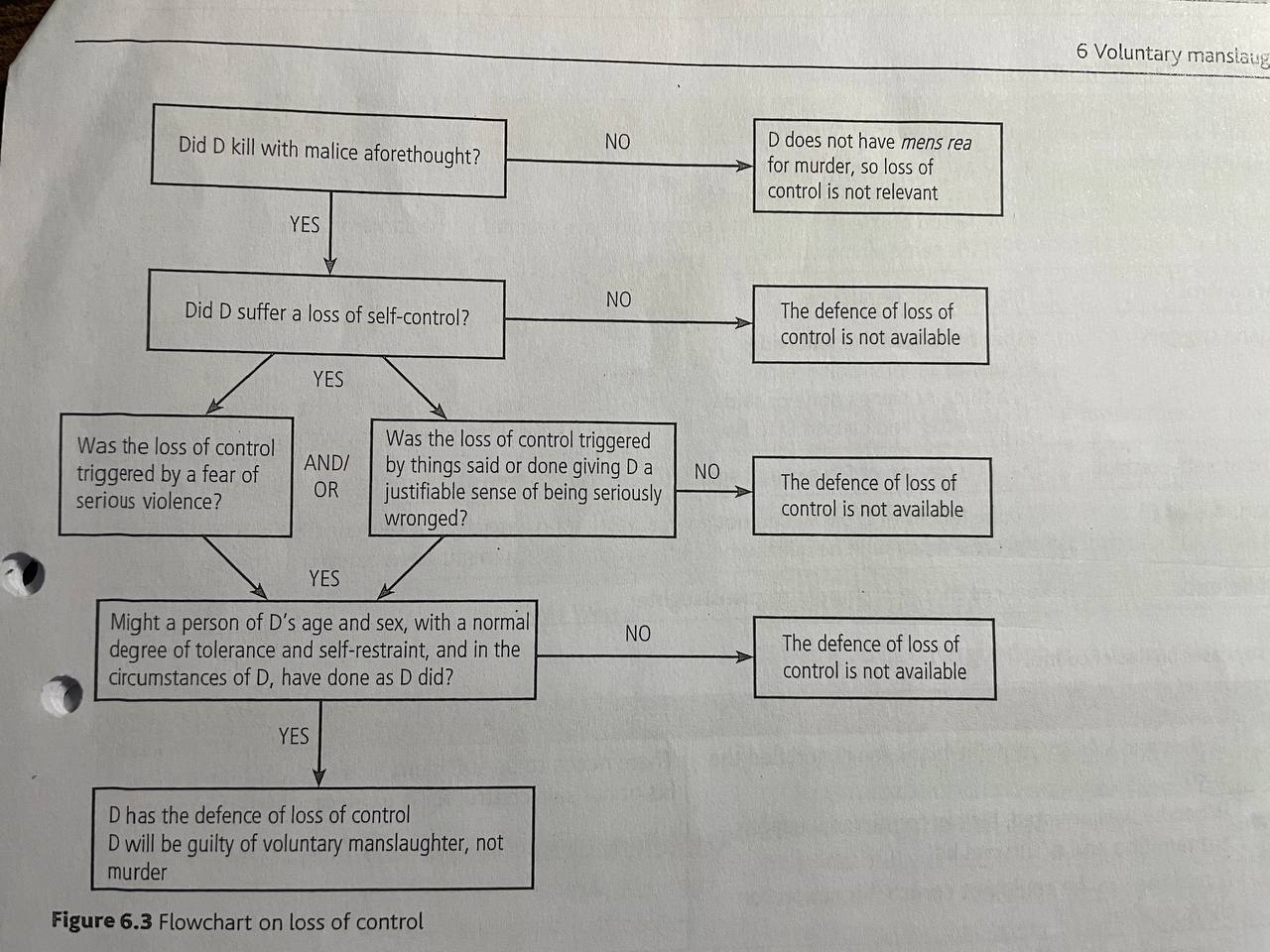volunt manslaughter
1/30
Earn XP
Description and Tags
special and partial defences to murder voluntary manslaughter: diminished responsibility and loss of control
Name | Mastery | Learn | Test | Matching | Spaced |
|---|
No study sessions yet.
31 Terms
what are the partial defences?
defence to murder that might reduce it to manslaughter
what is the special/partial ?
special- only apply to murders,the jury is not bound to accept this evidence.
partial- D is not completely acquitted and sentence is reduced to vol manslaughter; DR , L of C
when was DR introduced and amended?
by the Homicide Act 1957;
amended by S52 of the Coroners and Justice Act 2009
what does the defence say(DR)? which type of defence is it?
(DEF.) partial defence
A person or is party to a killing of another is not to be convicted of murder if he was suffering from an abnormality of mental functioning which
arise from a recognised medical condition
substantially impair the accused’s ability to understand nature of their conduct, form a rational judgement or exercise self-control
provide an explanation for the accused’s actions or omissions.
who does burden of proof rest with?
the D has to prove it but only on the balance of the probabilities
what does the abnormality of mental functioning mean? + case
cover minds activities in all its aspects, inc the ability to exercise will power to control physical acts; different state of mind, that reasonable person would term it abnormal e.g. R V Byrne
what must ab of men funct be caused by?
from a “recognised medical condition “
when can physical causes qualify?
when they affect mental functioning e.g. epilepsy, sleep disorders
whet must D present to support a defence of DR?
med evidence of abnormality that the D is suffering from must be present at the trial
definition of substantially impaired + case
means an impairment which was of some importance or was a serious degree of impairment, more than trivial e.g. R V Gold
what must be substaintially impaired? (3)
ability to understand the nature of their conduct ( D suffers from delusions, believes, severe learning difficulties)
ability to form a rational judgement ( unable judge their acts/ omissions)
ability to exercise self control e.g. RV Byrne
what means providing an explanation for Ds conduct?
D has to connect his ab of men funct with the killing
flowchart of DR

when D is intoxicated at the time of the killing - 3 types:
D was intoxicated at the time of the killing and tries to use the defence
D was intoxicated and has a pre existing ab of men funct e.g. Dietschmann
the intoxication is due to an addiction
1.can the intoxication be qualified as a defence? + case
cannot be used as the basis of a defence of DR on its own , requires ab of men funct e.g.Dowds
2.D was intoxicated and has a pre existing ab of men funct + case
Dietschmann - it was unlikely that without drinks he would kill which means that ab of men funct on its own was insufficient to impair his responsibility
3.intoxication was due to an addiction
Wood, Stewart in both the murder was reduced to manslaughter on the grounds of DR; ADS can be ab of men funct
what type of defence is loss of control? where is it set out?
a partial defence to a charge of murder, D will be guilty of voluntary manslaughter; set out in section 54(1) of the coroners and Justice act 2009; DOES NOT HAVE TO BE SUDDEN
what are the elements of loss of control?
D must have lost self control
there must be a qualifying trigger
a person of D's sex and age, with a normal degree of tolerance and self-restraint and in the circumstances of D, might have reacted in the same or in a similar way to D.
loss of self control(3)…. + 2 cases and section
section 54 (1)(b) it is up to juries to decide; However it might be proved if:
D lost their ability to maintain their action in accordance with considered judgement
D lost their normal powers of reasoning
Ds behaviour was atypical, normally they would not behave in this way
Jewell- temper, anger reaction are NOT sufficient , D did not have sufficient evidence
Ahluwalia - was able to claim the defence l of c bc from “combination of fear, anger, frustartion and a sense of desperation”
where are the requirements for the qualifying trigger set?
section 55(1)
Diagram for the qualifying trigger

what type of test is established for fear of serious violence? case + section
section 55(3) D will need to show they lost self control bc of a genuine fear of violence whther or not the fear was reasonable
Dawes
what are the 2 requirements for things done/said?
they were of an extremely grave character
caused D to have a justifiable sense of being seriously wronged
what type of test is used to determine whether D can claim that his sense of being was seriously wronged is justified?
an objective questions to the jury to decide ( assuming that there is sufficient evidence of the defence to be considered)
how does objective q for a jury to determine whether D can claim that his sense of being seriously wronged is justified affect the availability of l of c?
to narrow the potential availability of this defence
cases for things said or done( provocation/L of C) + Section
section 55(4)
Doughty- able to use provocation as its up to the jury to decide, might not be able to use l of c bc no reasonable person would commit it
Zebedee- cannot use L of C bc neither of the elements for qual trigger were present
excluded matters + the cases
Sexuality infidelity cannot be used on its own as a qual trigger for loss of control, there have to be another trigger as things done/said as in case Clinton - trigger was that V taunts D
Revenge - Ibrams and gregory - D had time to plan the revenge even though the loss of control does not have to be sudden, Ds made a plan, DEPENDS ON how much time has passed
Ballie - there was a sudden lost of control the provocation is available , however were present the elements of a desire for revenge
Standard of self control: what level of control is D expected to show?what would be included and not/
Included: objective test for the jury to consider, such as a person of Ds age and sex would act i the same way
Cannot be included: personality disorder
Reaction in the same or similar way + case
the jury should decide whether same person would become angry and lose self control and kill or would become angry and lose control BUT not to that level that D went - Van Dongen (cannot use defence bc same person would not go to that level as D did)
flowchart of loss of control
